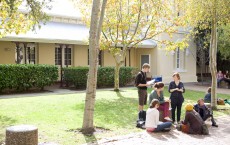
The school has a long and proud tradition of producing outstanding graduates . Special recognition is given to the school’s place in Africa, and the School strives to provide a stimulating and supportive environment in which both undergraduate and postgraduate students can achieve their full potential. During their studies students have access to an impressive range of resources and facilities and Michaelis’s location on UCT’s Hiddingh Campus – adjacent to the historic Company’s Garden – ensures that students have access to many cultural institutions and heritage resources. These include the Iziko South African National Gallery, the South African Museum and the National Library of South Africa, as well as some of the country’s leading commercial art galleries and creative hubs. A shuttle service links the campus with the main university campus in Rondebosch.
Workshops and Labs
The School has beautiful heritage buildings with good space and light that provide generous, unique and appropriate studios for the study and practice of Fine Art. An impressive array of facilities is available to students comprising excellent computer laboratories and workshops that are well equipped. Specialised technical staff instruct students in the use of equipment and provide help with projects.
Facilities include bronze casting and ceramic kilns, metal and wood workshops, etching, lithography, relief and screenprinting workshops, photographic studios, darkrooms and digital processing laboratories, video editing suites, iMac based computer labs and a new digital fabrication workshop with a computer aided laser cutter and router.
Wifi internet connectivity is available across campus.
The Michaelis Galleries

With some 200 square meters of state of the art gallery space, the Michaelis Galleries host a wide range of temporary exhibitions throughout the year. Regular collaborations with staff members, alumni and local and international visual arts organizations bring noteworthy art shows to these venues, whilst experimental and emerging artists’ and curators’ shows are hosted under the banner of ‘Michaelis Lab’. The galleries are a unique opportunity for staff and students of the university to exhibit their artworks or curated exhibitions in a non-commercial, experimental space. The galleries also form an invaluable teaching resource, allowing students to learn and hone curatorial and exhibition design and management skills.Whilst the gallery complex is unique in that it is situated on a university campus, it is open to visitors from the general public. In keeping with a mission of promoting and celebrating the visual arts in a broad community context, the gallery regularly presents open lectures, walkabouts and workshops. See past and current exhibitions here.
The campus

The school incorporates sections of Painting, Sculpture, Printmedia, Photography and New Media, the Centre for Curating the Archive, the Katrine Harries Print Cabinet, and the Michaelis Gallery. Buildings on the Hiddingh campus also house the Department of Drama, the Little Theatre, Arena Theatre, Hiddingh Hall Library and the Iziko Bertram House Museum. At the Michaelis Gallery, visitors to the campus can view regular exhibitions by local and international artists. The gallery also hosts an annual end-of-the-year exhibition of fourth-year student works, a highlight of the South African arts calendar.
The history of the campus

Founded in 1925, the Fine Arts department of the University of Cape Town is better known as the Michaelis School of Fine Art, named for Sir Max Michaelis, who in 1920 endowed the chair of Fine Art at the University. The school is situated in Cape Town in the group of buildings around the Hiddingh Hall, between Orange Street and the upper end of the Avenue, in the Gardens. This complex is known as the Hiddingh Campus and forms the nucleus of the original historical campus of the South African College, later the University of Cape Town. The Egyptian Building dates from 1839 and is the oldest building in South Africa built for tertiary education. It is a national monument.
